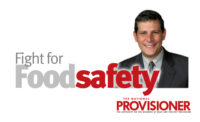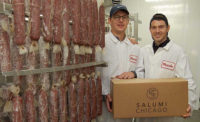Persistence can be good or bad. It’s generally considered a good thing when used to describe a person’s character or willingness to go the extra mile. It’s typically regarded as bad when used to describe a recurring problem or nuisance that simply won’t resolve. And, it can be nightmarish when used to describe pathogenic bacteria which have colonized somewhere within the food-processing environment.
So, how do we prevent pathogens from gaining a foothold in processing facilities? As we all know, cleaning and sanitizing food-production areas throughout the day and, more extensively, between production shifts, is an essential part of ensuring the food we produce is safe. In addition to the daily cleansing of floors, walls and ceilings, we must also clean our equipment.
Equipment should be broken down and disassembled so it can be easily accessed and sanitized. And, prior to the beginning of each new day, as the walls dry and floors are squeegeed, equipment and belts should be presented for inspection. Once we pass these daily pre-operational checks, the cycle again resumes.
Despite such efforts, however, many companies continue on occasion to find pathogens in raw products. Mostly, this is because pathogens on incoming cattle can find their way into the finished product. But, new research is suggesting that sometimes this can occur because pathogens such as E. coli O157:H7, under certain circumstances, can colonize within the slaughter environment itself.
As noted, we know that pathogens enter slaughter facilities on the hides of carcasses. We also know that these pathogens can sometimes be present at very high levels. Once they’ve actually entered the facility, we simply ask, “to what extent can we reduce the incoming loads before the final product is shipped?”
While interventions play an integral role, so too does the type and age of the equipment over which (or under which) the food products travel. For this reason, it is absolutely critical, at the outset, to ensure that equipment is serviceable. And, processing equipment should be free of any visible defects.
Although your processing equipment may have served well for many years, age may be beginning to show. Stress cracks or fractures can develop in deep corners and escape inspection. If they escape inspection, they can also potentially escape cleaning and sanitizing. And, if not properly cleaned and sanitized, existing blemishes could potentially harbor pathogens. If colonies develop (remember, bacteria needs only moisture and food to grow), they could potentially contaminate products on an ongoing basis.
So, fight back with your own persistence. The type that is good. Make doubly sure that your equipment is serviceable and defect-free. Look for stress cracks and harborage areas. Try to find those places where bacteria, if allowed to persist, could impact products traveling over the surface or even below.
And, in addition to ensuring that your equipment is serviceable, consider more effective ways to clean and sanitize the equipment you use. This may include upgrading your equipment to newer models, or perhaps even embracing the newest technology. This might even include the latest clean-in-place models, where the equipment cleans itself without the need for disassembly. These technologies, when utilized appropriately, can vastly increase efficiency and ensure a much safer product.
So, when it comes to maintaining, cleaning and sanitizing production equipment, persistence can and will pay off. The more persistent we can be, the less persistent pathogens will be.
Shawn K. Stevens defends and counsels meat companies in foodborne illness matters throughout the United States. Mr. Stevens also assists industry clients with regulatory compliance, recall planning, crisis management and other issues in advance of and following major food-product recalls. Additional information about his practice can be found at www.defendingfoodsafety.com.
When Persistence Pays Off







